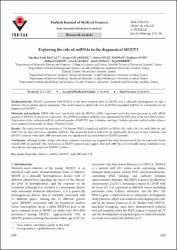| dc.contributor.author | Baltacı, Oğuzhan Fatih | en_US |
| dc.contributor.author | Çolakoğlu, Şeyma | en_US |
| dc.contributor.author | Güllü Amuran, Gökçe | en_US |
| dc.contributor.author | Aydın, Neslihan | en_US |
| dc.contributor.author | Sargın, Mehmet | en_US |
| dc.contributor.author | Karabay, Arzu | en_US |
| dc.contributor.author | Yılmaz, Temel | en_US |
| dc.contributor.author | Berber, Ergül | en_US |
| dc.date.accessioned | 2019-05-30T10:08:53Z | |
| dc.date.available | 2019-05-30T10:08:53Z | |
| dc.date.issued | 2018 | |
| dc.identifier.citation | Baltaci, O. F., Colakoglu, S., Gullu Amuran, G., Aydin, N., Sargin, M., Karabay, A., . . . Berber, E. (2018). Exploring the role of miRNAs in the diagnosis of MODY3. Turkish Journal of Medical Sciences, 48(3), 620-+. doi:10.3906/sag-1711-98 | en_US |
| dc.identifier.issn | 1300-0144 | |
| dc.identifier.issn | 1303-6165 | |
| dc.identifier.uri | https://hdl.handle.net/20.500.12294/1436 | |
| dc.description | Berber, Ergül (Arel Author) | en_US |
| dc.description.abstract | Background/aim: MODY3 associated with HNF1A is the most common form of MODY and is clinically misdiagnosed as type 1 diabetes due to similar clinical symptoms. This study aimed to analyze the role of HNF1A-regulated miRNAs as a biomarker in the diagnosis of MODY3. Materials and methods: MIN6 cells were transfected with the HNF1A cDNA expression vector for overexpression or with siRNA specific to HNF1A to silence its expression. The HNF1A-regulated miRNAs were determined by RNA-Seq of the total RNA extract. Expressions of the candidate miRNAs in blood samples of MODY3, type 1 diabetes, and type 2 diabetes patients and in healthy subjects were compared statistically by Mann-Whitney U tests.Results: This study revealed the presence of 238 known HNF1A-regulated miRNAs in MIN6 cells. miR-129-1-3p, miR-200b-3p, and miR-378a-5p were selected as candidate miRNAs. The expression level of miR-378a-5p significantly decreased in type 2 diabetes and MODY3 patients, while miR-200b-3p expression was significantly decreased only in MODY3 patients. Conclusion: Although further studies with larger numbers of patients are required, this study demonstrated that the expression levels of miR-200b-3p and miR-378a-5p decrease in MODY3 patients and suggests that miR-200b-3p is an especially strong candidate to use clinically for selecting suspected MODY3 patients. | en_US |
| dc.language.iso | eng | en_US |
| dc.publisher | TUBITAK | en_US |
| dc.relation.ispartof | Turkish Journal of Medical Sciences | en_US |
| dc.identifier.doi | 10.3906/sag-1711-98 | en_US |
| dc.identifier.doi | 10.3906/sag-1711-98 | |
| dc.rights | info:eu-repo/semantics/openAccess | en_US |
| dc.subject | Biomarker | en_US |
| dc.subject | Diabetes | en_US |
| dc.subject | miRNA | en_US |
| dc.subject | MODY3 | en_US |
| dc.subject | miR-200 | en_US |
| dc.subject | miR-378 | en_US |
| dc.title | Exploring the role of miRNAs in the diagnosis of MODY3 | en_US |
| dc.type | article | en_US |
| dc.department | İstanbul Arel Üniversitesi, Fen-Edebiyat Fakültesi, Moleküler Biyoloji ve Genetik Bölümü | en_US |
| dc.identifier.volume | 48 | en_US |
| dc.identifier.issue | 3 | en_US |
| dc.identifier.startpage | 620 | en_US |
| dc.relation.publicationcategory | Makale - Uluslararası Hakemli Dergi - Kurum Öğretim Elemanı | en_US |
| dc.relation.tubitak | info:eu-repo/grantAgreement/TUBITAK/SOBAG/113S217 | |


















